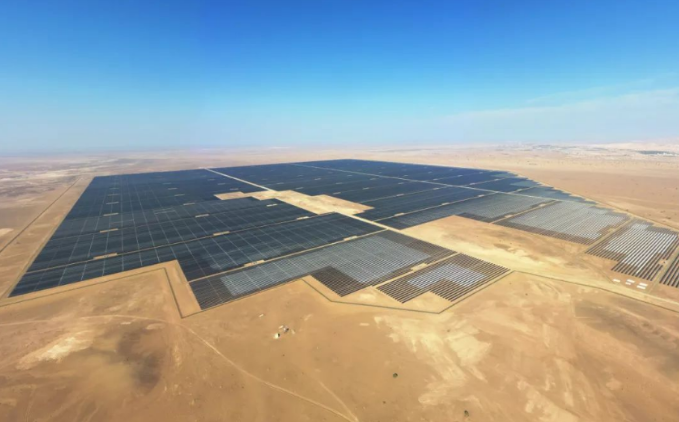PVTIME – The Middle East PV solar market is booming! It reached an impressive US$6.93 billion in 2023 and is expected to reach a whopping US$37.71 billion by 2030, growing at a CAGR of 27.4% – an absolutely incredible rate of growth!
As the global energy transition gathers pace, Saudi Arabia, the Middle East’s energy powerhouse, is the new focus of the global PV industry – and it’s an exciting time for the industry! Saudi Arabia’s ‘Vision 2030’ plan is a game-changer for energy! It is taking the initiative to modernise its energy sector and guarantee the reliability and stability of its power supply with 50% of energy coming from renewable sources by 2030, which is great news for the photovoltaic industry!
The incredible new energy development momentum is drawing in PV providers from all over the globe, especially Chinese manufacturers! In a bold move, several leading Chinese photovoltaic companies have announced plans to build factories in the Middle East. This is fantastic news for the region, as it signals the rapid formation of a vibrant photovoltaic industry chain spanning the upstream and downstream of polysilicon and crucial supporting materials.
On 16 July 2024, TCL Zhonghuan Renewable Energy Technology Co. Ltd. (TCL Zhonghuan, 002129.SZ), a leading Chinese solar silicon wafer manufacturer, announced that it has signed an agreement with Vision Industries Company (Vision Industries) and Renewable Energy Localization Company (RELC) to jointly establish a large-scale solar wafer factory in Saudi Arabia. The new facility will be the first photovoltaic wafer project in Saudi Arabia and the largest in the world, and is expected to produce 20GW of silicon wafers per year with an estimated investment of US$2.08 billion. A joint venture will be set up by the three companies to manage the investment and construction of the factory and to distribute the products.

On the same day, JinkoSolar, the world’s leading PV and ESS supplier, announced the signing of a shareholders’ agreement with Vision Industries Company (Vision Industries) and Renewable Energy Localization Company (RELC) to establish a large-scale solar cell and module factory in Saudi Arabia. The plant is expected to produce 10GW of high efficiency solar cells and modules per year with an estimated investment of US$1 billion.
These new projects are important steps in promoting the transition to new energy sources in the Middle East and North Africa region. They will enable Saudi Arabia to localise advanced renewable energy technologies and maximise local content to meet domestic, regional and international demand. They support the PIF’s efforts to position Saudi Arabia as a global exporter of renewable energy products and services. The involvement of Vision Industries and Chinese companies demonstrates PIF’s strategy to attract international investment and strengthen local supply chains.
In addition, in July 2024, Sungrow entered into a significant agreement with Algihaz Holding in Saudi Arabia, marking the largest energy storage order in the world to date. The project comprises three sites with a total installed capacity of 7.8GWh, located in the Najran, Madaya and Khamis Mushait regions of Saudi Arabia. Delivery is scheduled to start in 2024. The order value is expected to be in excess of 7.8 billion yuan to 10 billion yuan (US$1.074 billion to US$1.377 billion) at a price range of 1 to 1.5 yuan/Wh (US$0.14 to US$0.21/Wh). As a global leader in PV and energy storage with cutting-edge solar energy solutions for various applications, Sungrow will supply more than 1,500 sets of PowerTitan 2.0 liquid-cooled energy storage systems with integrated AC storage and high energy density to support the plants in a high-temperature environment. This solution will result in a 55% reduction in floor space. In addition, CALB Tech will supply approximately 7.8 million battery cells. The 2GWh order for the first phase of the project was won by BYD and China Electric Equipment Group as ES system and EPC providers respectively.
Prior to this Saudi project, the world’s largest energy storage projects were 1.3GWh in the Red Sea, developed by ACWA Power and won by Huawei in October 2021, and then 4.1GWh in the Atacama Oasis in Chile, won by BYD in January 2024, all of which are now overshadowed by this new 7.8GWh project.
After Saudi Arabia embarked on a journey towards a brighter future with the launch of Vision 2030 in 2016, a number of leading Chinese PV companies announced their plans to join hands with Saudi companies.
Shanghai Electric signed a memorandum of understanding with Saudi Arabia’s ACWA Power, a leading Saudi developer, investor and operator of power generation, to jointly develop renewable energy projects, including gas turbine construction, desalination development, thermal, photovoltaic, solar thermal, wind and combined cycle power generation.
Energy China was selected as the EPC for the 300MW Rabigh photovoltaic power plant in Saudi Arabia. It is estimated that the Rabigh project could generate an average of 2240kWh per kilowatt per year. The total power generation in the first year was 894GWh, equivalent to the reduction of carbon dioxide emissions of about 779,900 MT, effectively optimising the energy structure and protecting the local ecological environment. This plant was connected to the grid in May 2023, providing 45,300 households with green and clean electricity, effectively optimising the energy structure and protecting the local ecological environment.

ACWA Power has signed an EPC contract with ENERGY CHINA for the second phase of the 2.6GW Arabia Al Shuaibah PV project. The project, initiated by power developer ACWA Power with the support of Saudi Arabia’s Public Investment Fund (PIF), is expected to strengthen and diversify the power supply in the region, which is home to over 8 million people and attracts millions more each year through pilgrimages to the holy site known as the Kaaba.
In February 2022, Jinko Power won a 300MW PV project in Saudi Arabia. The total investment of the project was approximately US$209 million. Upon completion, the average annual power generation of the project is expected to be 876 million kWh.
In the same year, China’s SPIC and Jinko Power won power purchase agreements (PPAs) for 1GW of solar power plants from Saudi Power Procurement Company (SPPC) in Saudi Arabia. SPPC signed a 700MW solar power plant in the Qassim region of the Kingdom of Saudi Arabia with Ar Rass Solar Energy Co, owned by a consortium led by ACWA Power, SPIC and Water and Electricity Holding Company (WEHC), with a total investment of SR1.7 billion. The off-taker also signed the 300MW Saad PV IPP in Saad, within the Riyadh region, with a total investment of SR800 million and an LCOE of 5.56 HH/kWh. This PPA was signed with a consortium led by Jinko Power (HK) as the managing and technical member, Jinko Power Middle East Holding Co. Ltd and Jinko Power Dhafra Holding Co. Ltd as consortium members.
In April 2022, LONGi won a contract to supply 406MW of its Hi-MO 5 bifacial modules to SEPCOIII Electric Power Construction Co., Ltd. for the Red Sea Project in Saudi Arabia. The project will be powered entirely by renewable energy on a scale not previously achieved anywhere in the world, with energy generated by solar panels and wind turbines to meet an initial demand of 210MW, with further expansion planned. In May 2022, LONGi won another contract to supply 400MW of high efficiency solar panels for the Rabigh Solar Project in Saudi Arabia.
In 2023, Arctech, the world’s leading provider of solar tracking, racking and BIPV, has announced that it will supply 1.5GW of SkyLine II solar tracking solutions for the ASB project in Saudi Arabia. This particular project is located in the Al Shubakh district, Jeddah City, Mecca, Saudi Arabia, with a total installed capacity of 2.6GW, making it the largest photovoltaic power plant project in the Middle East at that time, as part of Saudi Arabia’s new energy plan, Vision 2030.

In September 2023, Jinko Power announced its plans to build a 400MW solar power plant in northern Saudi Arabia. The project will be carried out by Jinko Power Hong Kong with a total investment of US$315 million, equivalent to 2.3 billion yuan. The project will be located in Al-Jouf, approximately 17 kilometres northwest of Tabarjal, a city in the northern region of Saudi Arabia, an area that benefits from extensive sunshine and abundant light resources. The project has been designed to generate up to 450MW of electricity under a build-own-operate (BOO) model. The expected construction period for this particular project is 21 months, while the plant is expected to operate for a period of 30 years. Upon completion, the plant is expected to have an estimated annual equivalent capacity utilisation of 2,874 hours with an expected average annual electricity output of approximately 1,245 million kWh. The internal rate of return is estimated to be around 8% and the payback period is expected to be around 14 years.
Also in September, GCL Tech, a leading polysilicon producer, announced its intention to launch a 120,000 tonnes per year silicon production initiative in the Middle Eastern country of Saudi Arabia. The new facility is expected to be operational as early as 2025.
Then in December, Yingli Energy Development Co., Ltd. (Yingli Solar) announced that it will supply 1.25GW of its n-type PANDA series TOPCon solar modules for the Saad 2 solar power project in Saudi Arabia. The project is part of the third round of photovoltaic project planning for the PIF.

In May 2024, Sungrow entered into a partnership with Larsen & Toubro to supply 160MW/760MWh of energy storage systems and 165MW of PV inverters for AMAALA, a luxury tourism project in Saudi Arabia. Previously, Sungrow also signed a memorandum of understanding with ACWA Power to supply 600MW of energy storage for NEOM, a futuristic region in north-west Saudi Arabia powered by 100% renewable energy.
Many other Chinese solar companies are planning to enter the renewable energy business in Saudi Arabia, such as Huasun, which partnered with Adir Energy to distribute high-efficiency HJT solar modules in Saudi Arabia, JZNEE (Jiangsu Zhenjiang New Energy Equipment), a Chinese solar equipment company, announced a strategic partnership with a US-based provider of photovoltaic tracking solutions, with plans to co-invest in a state-of-the-art manufacturing facility in Ad Dammām, Saudi Arabia, and so on.
Why is Saudi Arabia so attractive to Chinese PV companies?
The country is blessed with abundant sunlight resources, with average annual solar irradiation generally above 2000 kWh/m2, making it one of the best regions for PV resources in the world, perfect for solar energy deployment with a strong sense of energy transition, a better economic base and strong political support.
Saudi Arabia unveiled to the world a national plan called Vision 2030, which promotes the diversification of the country’s economy through investment by sovereign funds to reduce its dependence on energy exports as a single pillar of the economy. It clearly identified the growth of renewable energy as one of the key ways to achieve this goal, with a plan to increase renewable energy capacity to 58.7GW by 2030, a target that has now been raised to 130GW. Among these, solar PV occupies a dominant position. This huge market demand has attracted many photovoltaic companies to invest and build factories.
The Saudi government uses tenders to attract international PV companies to participate in its renewable energy projects. In recent years, the Saudi Power Purchasing Company (SPPC) has signed power purchase agreements for three new solar photovoltaic (PV) projects with ACWA Power, Badeel, a water and electricity company, and Saudi Aramco Power. The three projects will add a total of 5.5GW of solar power capacity. As part of Saudi Arabia’s National Renewable Energy Programme (NREP), they will help the country meet its target of 50% renewable energy by 2030. The three projects are Haden Solar PV and Al-Muwaih Solar PV in Makkah Province with a capacity of 2GW, and Al-Khushaybi Solar PV in Qassim Province with a capacity of 1.5GW. Since the launch of the NREP, Saudi Arabia has approved 21 projects with a total capacity of 19GW. Of these, seven projects are operational and connected to the grid with a total installed capacity of 4.1GW, eight projects are under construction with an installed capacity of 8.2GW, and six projects are in the final stages of financial close with a total capacity of 7GW.
Saudi Arabia plans to approve contracts for new renewable energy projects every year from 2024, with a target maximum annual increase in installed capacity of 20GW. By 2030, it expects to have between 100GW and 130GW of renewable energy capacity, the exact size of which will depend on growth in electricity demand.
In addition, the Saudi government has reduced the cost of PV projects by providing financial subsidies, tax incentives and other incentives to attract international companies to invest. These policies are helping to improve the economics and feasibility of PV projects. The localisation of the PV supply chain is actively promoted, and international companies are encouraged to set up production bases and R&D centres in Saudi Arabia, reducing transport costs and time and promoting local employment.
Saudi Arabia’s unique natural advantages are attractive. Saudi Arabia is located in the Middle East region and has abundant light resources, providing unique natural conditions for the development of the photovoltaic industry. As an oil-exporting country, Saudi Arabia has strong economic power and a stable political environment, providing a good investment environment for PV companies. Located in the heart of the Middle East, Saudi Arabia is easily accessible for the transportation and export of PV products. It is also a hub between Europe and Africa, where a base is conveniently located and widely distributed.
The huge potential of Saudi Arabia’s demand for PV, the favourable policies offered by the government, and the favourable conditions of the market itself have combined to attract many PV companies to enter the Saudi market. The investment and construction of facilities in Saudi Arabia by these companies will not only help to promote the development of renewable energy in Saudi Arabia, but will also contribute to the prosperity of the global PV industry.

Scan the QR code to follow PVTIME official account on Wechat for latest news on PV+ES











